Tinariwen and Dengue Fever: Dancing for joy and sorrow at the Fonda
Steve Hochman on
0

The Golden Age of Phnom Penh pop and the electrified sounds of the Sahara came together Friday at the Fonda Theatre via the brilliant double-bill pairing of Dengue Fever and Tinariwen — arguably the world leaders in their respective forms. Strike that. There is no argument about it. They are the leaders.
Opener Dengue Fever started life more than 15 years ago as a Cambodian-pop-obsessed L.A. alt-rock band grafted with a real-deal Cambodian singer, the astounding Chhom Nimol, discovered by brothers Ethan and Zac Holtzman singing in a restaurant in the Little Phnom Penh community of Long Beach. Friday, as always, it rocked and bounced with a happy sound forged in the ’60s from a mix of Cambodian sounds and Western garage-psyche-pop-rock that made for the soundtrack to that country’s modern golden age. And the audience rocked and bounced with it, including some particularly, uh, enthusiastic frat-boy dancing.
It was hard not to, from the surfy rock of set starter “Lost in Laos” to the dense powerhouse/bouncy-castle stomp of its closing “1000 Tears of a Tarantula.” Along the way were some colorful side trips, notably “New Year’s Eve,” with its a cappella tour-de-force intro by Nimol (who noted that Cambodian New Year is coming up in two weeks), and “Uku,” for which guitarist Zac Holtzman strapped on his double-neck Frankenstein hybrid of a JazzMaster and an electrified Cambodian two-stringed chapai — with saxman David Ralicke switching to flute it almost sounded like a Southeast Asian answer to Traffic. Throughout, Nimol bobbed and twirled, her Cambodian-design gown swishing along as she parried with her bandmates. “Tiger Phone Card,” her flirty duet with Holtzman and the only song of the night with English lyrics, was a total grin-fest.
With headliner Tinariwen, it was more about swaying and swirling, both in the sounds and the movements, musicians and audience members alike. And yes, frat-boys included again. The insinuating, sinewy mix of call-and-response vocal play, snaking guitar lines and burbling rhythms remains impressive and seductive, even if it’s no longer as novel as it was when the band first took the global stage in the early 2000s. Slow-groove was the dominant mood, starting with “Nizzagh Ijbal,” also the opener of the band’s powerful new album “Elwan,” Abdallah Ag Alhousseyni leading the way with trilling acoustic guitar lines and an almost meditative, subdued tone to his voice. A few songs later, group founder Ibrahim Ibrahim Ag Alhabib wandered on stage, all éminence grise or beatific priest, upping the power a little with electric guitar, but maintaining the somber countenance. Later Alhassane Ag Touhami stepped front, upping the intensity of the sound, gradually quickening the pace of the grooves, but never losing the depth.
The collective nature of the band, further accented by the members all wearing traditional Islamic robes and head and face coverings — save for Alhabbib, who keeps his tight-curled, graying hair uncloaked — is a strength, an element of exotic mystique for us westerners, and a reminder of the solid footing in tradition for the music. The encores provided the full framework, starting with Alhousseyni alone on stage for a solo acoustic piece that had echoes of the Iberian connections strong in Northwest Africa, followed by a full-group number that steadily built to a blurred fury, the musicians and singers lost in the power and dancing to the asymmetrical polyrhythms with ease that escaped most of the fans.
How much can one take joy from music (or any art) intrinsically tied to sorrow?
But then, that may not be all that escaped many of the fans this night, especially given that nearly all the songs were sung in either Khmer or Tamashek. Which raises a dilemma tied to music that is as old as, well, music itself: How much can one take joy from music (or any art) intrinsically tied to sorrow? And there is plenty of sorrow here. Both bands’ music is heavily shadowed by displacement, destruction and, yes, death, and by war and oppression in both colonial and post-colonial times. And as their music and renown have grown, they have both used the platform to highlight all that.
Original artists including Ros Sereysothea, Sinn Sisamouth and Pan Ron, from whom Dengue Fever draw their inspiration and much of their repertoire, were lost in, and likely killed by, the brutal Khmer Rouge regime that took over Cambodia in the early ’70s. Honoring them has been crucial to the band’s mission since its very first albums, recently reissued. (Full disclosure: This reviewer wrote the liner notes to the reissue of the 2003 debut, “Dengue Fever.”) Tinariwen was originally formed by Tuareg rebels living in Algeria as refugees from Mali — famously, as a boy, Alhabib witnessed his father’s execution — and is now cut off from its home by the ISIS forces that have taken over that region. That loss of place is core to the band’s recent music, profoundly, movingly so on the recent “Elwan,” much of it having been recorded in a very different desert — California’s Joshua Tree.
Dengue Fever’s intrinsic intent is to give life to the lost artists — the “ghost voices” or Cambodia. With Tinariwen, they are the spirits of their people, but with the sad irony of being ambassadors of a historically nomadic culture now wandering the globe to perform, but unable to go home. That all was more readily gleaned from Tinariwen’s performance Friday, for those in a mind to glean, the muted tones of much of the set shaded by that sadness. But Dengue’s vibrant celebration is an equally powerful statement in its act of remembrance. And it’s meant to make people dance. So dancing is an act of remembrance, of honoring, even if some of those dancing don’t know it. Yes, that includes you, frat-boy.
Photos by David Benjamin

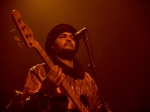
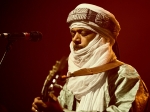
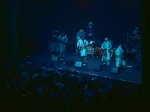

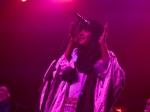
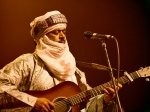
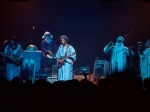
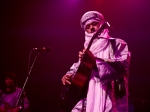
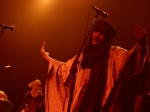


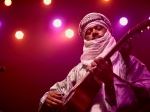
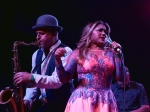
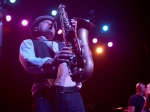


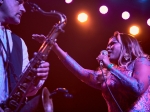

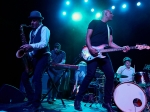
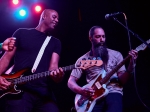
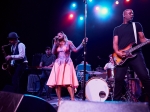




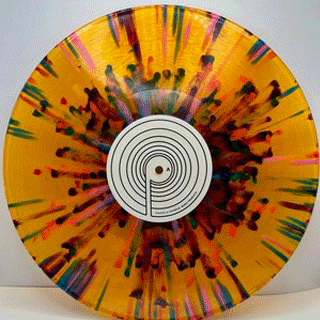

Leave a Reply